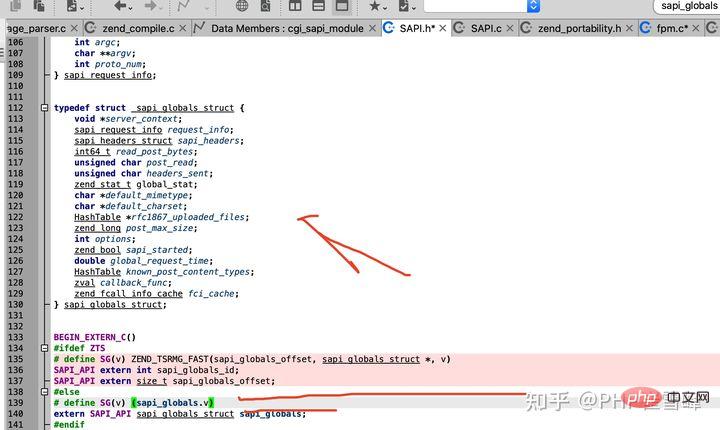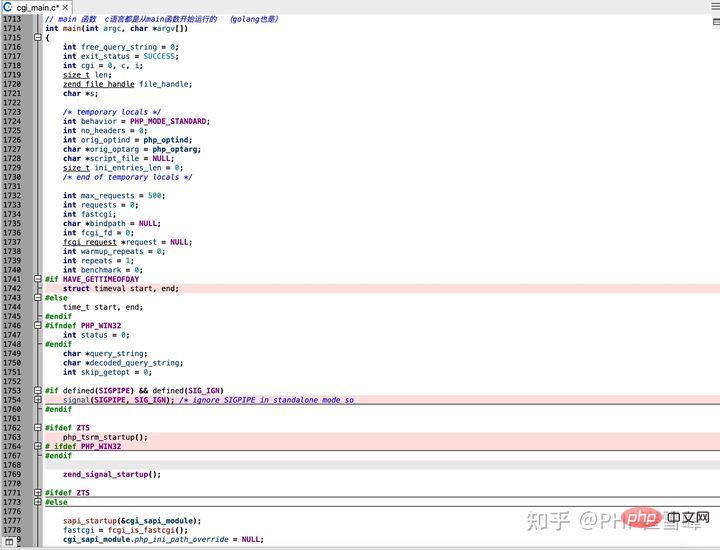深入解析PHP8底層核心原始碼之SAPI(一)
這篇文章給大家深入解析PHP8底層核心源碼,了解一下SAPI。有一定的參考價值,有需要的朋友可以參考一下,希望對大家有幫助。
)
相關文章推薦:《解析PHP8底層核心原始碼-陣列(一)》
在docker下搭建裡如下的環境
[root@a951700e857d cui-php]# php -v PHP 8.0.2 (cli) (built: Mar 2 2021 02:40:03) ( NTS ) Copyright (c) The PHP Group Zend Engine v4.0.2, Copyright (c) Zend Technologies [root@a951700e857d cui-php]#
引入一張鳥哥的圖
深入理解Zend SAPIs(Zend SAPI Internals)
#https://link.zhihu.com/?target=https://www.laruence.com/2008/08/12/180.html
)
SAPI(Server Application Programimg Interface,服務端應用程式介面)相當於PHP外部環境的代理程式。 PHP可以應用在終端機上,也可以應用在Web伺服器中,應用在終端機上的SAPI就叫作CLI SAPI,應用在Web伺服器中的就叫作CGI SAPI。
他相當於一個中間層或叫他膠水承上啟動作用
sapi的核心定義和巨集檔案在sapi.h中
)
# cgi_main.c裡面有個重要的結構體
//* sapi_module_struct cgi_sapi_module
static sapi_module_struct cgi_sapi_module = {
"cgi-fcgi", /* name */
"CGI/FastCGI", /* pretty name */
php_cgi_startup, /* startup */
php_module_shutdown_wrapper, /* shutdown */
sapi_cgi_activate, /* activate */
sapi_cgi_deactivate, /* deactivate */
sapi_cgi_ub_write, /* unbuffered write */
sapi_cgi_flush, /* flush */
NULL, /* get uid */
sapi_cgi_getenv, /* getenv */
php_error, /* error handler */
NULL, /* header handler */
sapi_cgi_send_headers, /* send headers handler */
NULL, /* send header handler */
sapi_cgi_read_post, /* read POST data */
sapi_cgi_read_cookies, /* read Cookies */
sapi_cgi_register_variables, /* register server variables */
sapi_cgi_log_message, /* Log message */
NULL, /* Get request time */
NULL, /* Child terminate */
STANDARD_SAPI_MODULE_PROPERTIES
};他」繼承「自結構體_sapi_module_struct
struct _sapi_module_struct {
char *name;
char *pretty_name;
int (*startup)(struct _sapi_module_struct *sapi_module);
int (*shutdown)(struct _sapi_module_struct *sapi_module);
int (*activate)(void);
int (*deactivate)(void);
size_t (*ub_write)(const char *str, size_t str_length);
void (*flush)(void *server_context);
zend_stat_t *(*get_stat)(void);
char *(*getenv)(const char *name, size_t name_len);
void (*sapi_error)(int type, const char *error_msg, ...) ZEND_ATTRIBUTE_FORMAT(printf, 2, 3);
int (*header_handler)(sapi_header_struct *sapi_header, sapi_header_op_enum op, sapi_headers_struct *sapi_headers);
int (*send_headers)(sapi_headers_struct *sapi_headers);
void (*send_header)(sapi_header_struct *sapi_header, void *server_context);
size_t (*read_post)(char *buffer, size_t count_bytes);
char *(*read_cookies)(void);
void (*register_server_variables)(zval *track_vars_array);
void (*log_message)(const char *message, int syslog_type_int);
double (*get_request_time)(void);
void (*terminate_process)(void);
char *php_ini_path_override;
void (*default_post_reader)(void);
void (*treat_data)(int arg, char *str, zval *destArray);
char *executable_location;
int php_ini_ignore;
int php_ini_ignore_cwd; /* don't look for php.ini in the current directory */
int (*get_fd)(int *fd);
int (*force_http_10)(void);
int (*get_target_uid)(uid_t *);
int (*get_target_gid)(gid_t *);
unsigned int (*input_filter)(int arg, const char *var, char **val, size_t val_len, size_t *new_val_len);
void (*ini_defaults)(HashTable *configuration_hash);
int phpinfo_as_text;
char *ini_entries;
const zend_function_entry *additional_functions;
unsigned int (*input_filter_init)(void);
};註解後如下
#struct _sapi_module_struct {
char *name; // 名字,如cli、 fpm-fcgi等
char *pretty_name; // 更易理解的名字,比如fpm-fcgi对应的为FPM/FastCGI
int (*startup)(struct _sapi_module_struct *sapi_module);
//模块启动时调用的函数
int (*shutdown)(struct _sapi_module_struct *sapi_module);
//模块结束时调用的函数
int (*activate)(void); // 处理request时,激活需要调用的函数指针
int (*deactivate)(void); // 处理完request时,使要调用的函数指针无效
size_t (*ub_write)(const char *str, size_t str_length);
// 这个函数指针用于输出数据
void (*flush)(void *server_context); // 刷新缓存的函数指针
zend_stat_t *(*get_stat)(void); // 判断对执行文件是否有执行权限
char *(*getenv)(char *name, size_t name_len); // 获取环境变量的函数指针
void (*sapi_error)(int type, const char *error_msg, ...)
ZEND_ATTRIBUTE_FORMAT(printf, 2, 3); // 错误处理函数指针
int (*header_handler)(sapi_header_struct *sapi_header,
sapi_header_op_enum op, sapi_headers_struct *sapi_headers);
//调用header()时被调用的函数指针
int (*send_headers)(sapi_headers_struct *sapi_headers);
// 发送全部header的函数指针
void (*send_header)(sapi_header_struct *sapi_header, void *server_context);
// 发送某一个header的函数指针
size_t (*read_post)(char *buffer, size_t count_bytes);
// 获取HTTP POST中数据的函数指针
char *(*read_cookies)(void); // 获取cookie中数据的函数指针
void (*register_server_variables)(zval *track_vars_array);
// 从$_SERVER中获取变量的函数指针
void (*log_message)(char *message, int syslog_type_int);
// 输出错误信息函数指针
double (*get_request_time)(void); // 获取请求时间的函数指针
void (*terminate_process)(void); // 调用exit退出时的函数指针
char *php_ini_path_override; // PHP的ini文件被复写的地址
void (*default_post_reader)(void); //负责解析POST数据的函数指针
void (*treat_data)(int arg, char *str, zval *destArray);
// 对数据进行处理的函数指针
char *executable_location; // 执行的地理位置
int php_ini_ignore; // 是否不使用任何ini配置文件
int php_ini_ignore_cwd; // 忽略当前路径的php.ini
int (*get_fd)(int *fd); // 获取执行文件的fd的函数指针
int (*force_http_10)(void); // 强制使用http 1.0版本的函数指针
int (*get_target_uid)(uid_t *); // 获取执行程序的uid的函数指针
int (*get_target_gid)(gid_t *); // 获取执行程序的gid的函数指针
unsigned int (*input_filter)(int arg, char *var, char **val, size_t val_len,
size_t *new_val_len);
// 对输入进行过滤的函数指针。比如将输入参数填充到自动全局变量$_GET、$_POST、$_COOKIE中
void (*ini_defaults)(HashTable *configuration_hash);
// 默认的ini配置的函数指针,把ini配置信息存在HashTable中
int phpinfo_as_text; // 是否输出phpinfo信息
char *ini_entries; // 执行时附带的ini配置,可以使用php -d设置
const zend_function_entry *additional_functions;
// 每个SAPI模块特有的一些函数注册,比如cli的cli_get_process_title
unsigned int (*input_filter_init)(void);
};這個結構體非常關鍵在CLI生命週期中,會呼叫其中定義的函數指標來實現各自的功能
另外還有一個重要的資料結構-sapi_globals,其對應的巨集為SG(v)

typedef struct _sapi_globals_struct {
void *server_context;
sapi_request_info request_info;
sapi_headers_struct sapi_headers;
int64_t read_post_bytes;
unsigned char post_read;
unsigned char headers_sent;
zend_stat_t global_stat;
char *default_mimetype;
char *default_charset;
HashTable *rfc1867_uploaded_files;
zend_long post_max_size;
int options;
zend_bool sapi_started;
double global_request_time;
HashTable known_post_content_types;
zval callback_func;
zend_fcall_info_cache fci_cache;
} sapi_globals_struct;這個SG 共560個位元組 整個PHP生命週期都多次用到了它
回過頭看cgi_main.c 整個cgi 的程式碼一共有900多行
)
折疊一些涉及ZTS (線程安全之類的)的程式碼

zend_signal_startup 訊號處理方法;(linux 訊號以後再講。坑挖的太大了)
呼叫sapi_startup(&cgi_sapi_module),對sapi_model進行一些初始化工作
...
sapi_startup(&cgi_sapi_module);
fastcgi = fcgi_is_fastcgi();
cgi_sapi_module.php_ini_path_override = NULL;SAPI_API void sapi_startup(sapi_module_struct *sf)
{
sf->ini_entries = NULL // ini_entries设置null
sapi_module = *sf; // 把传进来的结构体赋值给sapi_module
// 上面有关于sap_module的 定义 sapi_module_struct sapi_module;
//这里你可以理解为 初始化了sapi_module_struct
#ifdef ZTS
ts_allocate_fast_id(&sapi_globals_id, &sapi_globals_offset, sizeof(sapi_globals_struct), (ts_allocate_ctor) sapi_globals_ctor, (ts_allocate_dtor) sapi_globals_dtor);
# ifdef PHP_WIN32
_configthreadlocale(_ENABLE_PER_THREAD_LOCALE);
# endif
#else
sapi_globals_ctor(&sapi_globals);
#endif
#ifdef PHP_WIN32
tsrm_win32_startup();
#endif
reentrancy_startup();
}static void sapi_globals_ctor(sapi_globals_struct *sapi_globals)
{
memset(sapi_globals, 0, sizeof(*sapi_globals));
zend_hash_init(&sapi_globals->known_post_content_types, 8, NULL, _type_dtor, 1);
php_setup_sapi_content_types();
}##sapi_globals_ctor()內部邏輯
下面是 memset() 函数的声明。 void *memset(void *str, int c, size_t n) 参数 str -- 指向要填充的内存块。 c -- 要被设置的值。该值以 int 形式传递,但是函数在填充内存块时是使用该值的无符号字符形式。 n -- 要被设置为该值的字符数。 返回值 该值返回一个指向存储区 str 的指针。
/* {{{ php_startup_sapi_content_types */
int php_startup_sapi_content_types(void)
{
sapi_register_default_post_reader(php_default_post_reader);
sapi_register_treat_data(php_default_treat_data);
sapi_register_input_filter(php_default_input_filter, NULL);
return SUCCESS;
}sapi_startup(&cgi_sapi_module); fastcgi = fcgi_is_fastcgi(); cgi_sapi_module.php_ini_path_override = NULL;
int fcgi_is_fastcgi(void)
{
if (!is_initialized) {
return fcgi_init();
} else {
return is_fastcgi;
}
}int fcgi_init(void)
{
if (!is_initialized) {
#ifndef _WIN32
sa_t sa;
socklen_t len = sizeof(sa);
#endif
zend_hash_init(&fcgi_mgmt_vars, 8, NULL, fcgi_free_mgmt_var_cb, 1);
fcgi_set_mgmt_var("FCGI_MPXS_CONNS", sizeof("FCGI_MPXS_CONNS")-1, "0", sizeof("0")-1);
is_initialized = 1;
#ifdef _WIN32
# if 0
/* TODO: Support for TCP sockets */
WSADATA wsaData;
if (WSAStartup(MAKEWORD(2,0), &wsaData)) {
fprintf(stderr, "Error starting Windows Sockets. Error: %d", WSAGetLastError());
return 0;
}
# endif
if ((GetStdHandle(STD_OUTPUT_HANDLE) == INVALID_HANDLE_VALUE) &&
(GetStdHandle(STD_ERROR_HANDLE) == INVALID_HANDLE_VALUE) &&
(GetStdHandle(STD_INPUT_HANDLE) != INVALID_HANDLE_VALUE)) {
char *str;
DWORD pipe_mode = PIPE_READMODE_BYTE | PIPE_WAIT;
HANDLE pipe = GetStdHandle(STD_INPUT_HANDLE);
SetNamedPipeHandleState(pipe, &pipe_mode, NULL, NULL);
str = getenv("_FCGI_SHUTDOWN_EVENT_");
if (str != NULL) {
zend_long ev;
HANDLE shutdown_event;
ZEND_ATOL(ev, str);
shutdown_event = (HANDLE) ev;
if (!CreateThread(NULL, 0, fcgi_shutdown_thread,
shutdown_event, 0, NULL)) {
return -1;
}
}
str = getenv("_FCGI_MUTEX_");
if (str != NULL) {
zend_long mt;
ZEND_ATOL(mt, str);
fcgi_accept_mutex = (HANDLE) mt;
}
return is_fastcgi = 1;
} else {
return is_fastcgi = 0;
}
#else
errno = 0;
if (getpeername(0, (struct sockaddr *)&sa, &len) != 0 && errno == ENOTCONN) {
fcgi_setup_signals();
return is_fastcgi = 1;
} else {
return is_fastcgi = 0;
}
#endif
}
return is_fastcgi;
} 其中is_initialized 預設初始值為0
其中is_initialized 預設初始值為0
這篇寫的太流水帳了明天再補上吧先gdb分析cli模式
#本文經原作者PHP崔雪峰同意,發佈在php中文網,原文地址:https:/ /zhuanlan.zhihu.com/p/356037371
#推薦學習:《###PHP影片教學###》###以上是深入解析PHP8底層核心原始碼之SAPI(一)的詳細內容。更多資訊請關注PHP中文網其他相關文章!

熱AI工具

Undresser.AI Undress
人工智慧驅動的應用程序,用於創建逼真的裸體照片

AI Clothes Remover
用於從照片中去除衣服的線上人工智慧工具。

Undress AI Tool
免費脫衣圖片

Clothoff.io
AI脫衣器

AI Hentai Generator
免費產生 AI 無盡。

熱門文章

熱工具

記事本++7.3.1
好用且免費的程式碼編輯器

SublimeText3漢化版
中文版,非常好用

禪工作室 13.0.1
強大的PHP整合開發環境

Dreamweaver CS6
視覺化網頁開發工具

SublimeText3 Mac版
神級程式碼編輯軟體(SublimeText3)

熱門話題
 php5和php8有什麼差別
Sep 25, 2023 pm 01:34 PM
php5和php8有什麼差別
Sep 25, 2023 pm 01:34 PM
php5和php8的差異在效能、語言結構、型別系統、錯誤處理、非同步程式設計、標準函式庫函數和安全性等方面。詳細介紹:1、效能提升,PHP8相對於PHP5來說在效能方面有了巨大的提升,PHP8引入了JIT編譯器,可以對一些高頻執行的程式碼進行編譯和最佳化,從而提高運行速度;2、語言結構改進,PHP8引入了一些新的語言結構和功能,PHP8支援命名參數,允許開發者透過參數名稱而不是參數順序等等。
 php8怎麼加mysql擴展
Oct 07, 2023 pm 03:31 PM
php8怎麼加mysql擴展
Oct 07, 2023 pm 03:31 PM
php8加mysql擴充的步驟有:1.安裝MySQL客戶端函式庫;2、安裝PHP 8的開發工具;3、下載MySQL擴充原始碼;4、編譯和安裝MySQL擴充;5、啟用MySQL擴充;6、重啟Web伺服器即可。
 圖文詳解apache2.4+php8.0的安裝設定方法
Dec 06, 2022 pm 04:53 PM
圖文詳解apache2.4+php8.0的安裝設定方法
Dec 06, 2022 pm 04:53 PM
本文為大家介紹如何安裝apache2.4,以及如何設定php8.0,文中附有圖文詳細步驟,以下就帶大家一起看看怎麼安裝設定apache2.4+php8.0吧~
 php8怎麼連接資料庫
Nov 16, 2023 pm 02:41 PM
php8怎麼連接資料庫
Nov 16, 2023 pm 02:41 PM
PHP8可以使用mysqli和PDO來連接資料庫。詳細介紹:1、使用mysqli連接資料庫,透過傳入資料庫伺服器名稱、使用者名稱、密碼和資料庫名稱來連線。然後,使用`connect_error`屬性來檢查連線是否成功,如果連線失敗,則輸出錯誤訊息。最後,透過呼叫`close()`方法關閉連線;2、使用PDO連線資料庫,透過傳入資料庫伺服器名稱、密碼和資料庫名稱來進行連線等等。
 php8資料類型怎麼轉換
Nov 16, 2023 pm 02:51 PM
php8資料類型怎麼轉換
Nov 16, 2023 pm 02:51 PM
php8資料型別的方法有字串轉換為整數、整數轉換為字串、字串轉換為浮點數、浮點數轉換為字串、陣列轉換為字串、字串轉換為陣列、布林值轉換為整數、整數轉換為布林值和變數類型判斷和轉換。詳細介紹:1、字串轉換為整數包括intval()函數和(int)強制型別轉換;2、整數轉換為字串包括strval()函數和(string)強制型別轉換;3、字串轉換為浮點數等等。
 php8到底有哪些效能提升
Dec 21, 2023 pm 02:44 PM
php8到底有哪些效能提升
Dec 21, 2023 pm 02:44 PM
php8提高的效能包括:1、JIT編譯器的引進;2、函數呼叫的最佳化;3、垃圾回收機制的改進;4、型別系統的改良;5、新的語言特性;6、最佳化字串處理; 7.改進數組處理;8、引入新的記憶體管理機制;9、最佳化程式碼產生。詳細介紹:1、JIT編譯器的引入,PHP8引入了JIT編譯器,這是一種動態編譯技術,能夠將PHP程式碼轉換為機器碼,以便更有效率地執行;2、函數呼叫的最佳化等等。
 php8有什麼特性
Dec 21, 2023 pm 02:54 PM
php8有什麼特性
Dec 21, 2023 pm 02:54 PM
php8的特性:1、JIT編譯器;2、命名參數;3、聯合型別;4、註解;5、建構子屬性提升;6、match表達式;7、nullsafe運算子;8、改進型別系統;9 、錯誤處理改進;10、一致性改進。詳細介紹:1、JIT編譯器,PHP8引入了即時編譯技術,將PHP程式碼編譯成本機機器碼,從而提高程式的執行速度;2、命名參數,PHP8支援命名參數,允許在函數呼叫時使用參數名稱等等。







